6.1: Arches
- Page ID
- 42968
Arches are structures composed of curvilinear members resting on supports. They are used for large-span structures, such as airplane hangars and long-span bridges. One of the main distinguishing features of an arch is the development of horizontal thrusts at the supports as well as the vertical reactions, even in the absence of a horizontal load. The internal forces at any section of an arch include axial compression, shearing force, and bending moment. The bending moment and shearing force at such section of an arch are comparatively smaller than those of a beam of the same span due to the presence of the horizontal thrusts. The horizontal thrusts significantly reduce the moments and shear forces at any section of the arch, which results in reduced member size and a more economical design compared to other structures. Additionally, arches are also aesthetically more pleasant than most structures.
Types of Arches
Based on their geometry, arches can be classified as semicircular, segmental, or pointed. Based on the number of internal hinges, they can be further classified as two-hinged arches, three-hinged arches, or fixed arches, as seen in Figure 6.1. This chapter discusses the analysis of three-hinge arches only.
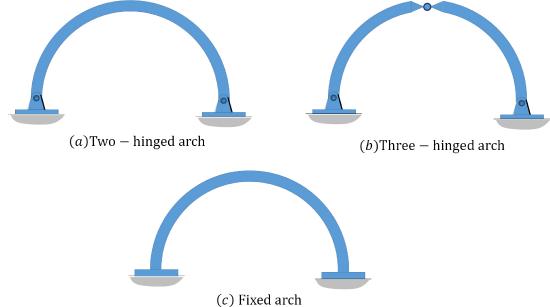
\(Fig. 6.1\). Types of arches.
Three-Hinged Arch
A three-hinged arch is a geometrically stable and statically determinate structure. It consists of two curved members connected by an internal hinge at the crown and is supported by two hinges at its base. Sometimes, a tie is provided at the support level or at an elevated position in the arch to increase the stability of the structure.
6.1.2.1 Derivation of Equations for the Determination of Internal Forces in a Three-Hinged Arch
Consider the section \(Q\) in the three-hinged arch shown in Figure 6.2a. The three internal forces at the section are the axial force, \(N_{Q}\), the radial shear force, \(V_{Q}\), and the bending moment, \(M_{Q}\). The derivation of the equations for the determination of these forces with respect to the angle \(\varphi\) are as follows:
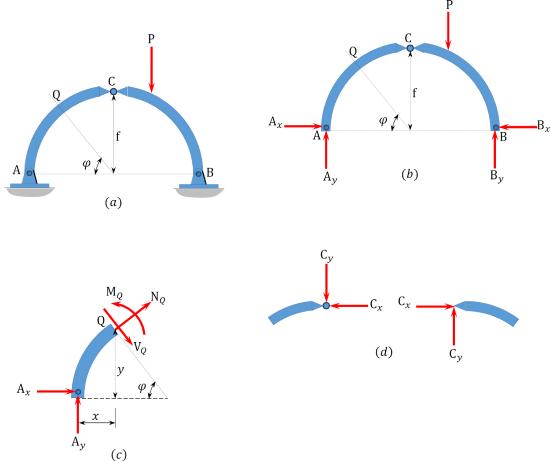
\(Fig. 6.2\). Three – hinged arch.
Bending moment at point \(Q\). \[M_{\varphi}=A_{y} x-A_{x} y=M_{(x)}^{b}-A_{x} y\]
where
- \(M_{(x)}^{b} =\) moment of a beam of the same span as the arch.
- \(y =\) ordinate of any point along the central line of the arch.
\[\text { For a parabolic arch, } y=\frac{4 f x}{L^{2}}(L-x)\]
\[\text { For a circular arch, } y=\sqrt{\mathrm{R}^{2}-\left(\frac{\mathrm{L}}{2}-x\right)^{2}} \mathrm{R}+f\]
- \(f =\) rise of arch. This is the vertical distance from the centerline to the arch’s crown.
- \(x =\) horizontal distance from the support to the section being considered.
- \(L =\) span of arch.
- \(R =\) radius of the arch’s curvature.
Radial shear force at point \(Q\).

\[V_{\varphi}=A_{y} \sin \varphi-A_{x} \cos \varphi=V^{b} \sin \varphi-A_{x} \cos \varphi\]
where \(V^{b}\) is the shear of a beam of the same span as the arch.
Axial force at a point \(Q\).
\[N_{\varphi}=-A_{y} \cos \varphi-A_{x} \sin \varphi=-V^{b} \cos \varphi-A_{x} \sin \varphi\]
Example \(\PageIndex{1}\)
A three-hinged arch is subjected to two concentrated loads, as shown in Figure 6.3a. Determine the support reactions of the arch.

\(Fig. 6.3\). Three – hinged arch.
Solution
The free-body diagrams of the entire arch and its segment \(CE\) are shown in Figure 6.3b and Figure 6.3c, respectively. Applying the equations of static equilibrium suggests the following:
Entire arch.
\(\begin{array}{l}
+\curvearrowleft \sum M_{A}=0 \\
E_{y}(45)-E_{x}(15)-50(5)-35(40)=0 \\
E_{y}(45)-E_{x}(15)=1650
\end{array}\)
Arch segment \(CE\).
\(\begin{array}{l}
+\curvearrowleft \sum M_{A}=0 \\
E_{y}(45)-E_{x}(15)-50(5)-35(40)=0 \\
E_{y}(45)-E_{x}(15)=1650
\end{array}\)
Solving equations 6.1 and 6.2 simultaneously yields the following:
\(\begin{array}{ll}
E_{y}=40 \mathrm{kN} & E_{y}=40 \mathrm{kN} \uparrow \\
E_{x}=10 \mathrm{kN} & E_{x}=10 \mathrm{kN} \leftarrow
\end{array}\)
Entire arch again.
\(\begin{array}{l}
+\uparrow \sum F_{y}=0 \\
A_{y}+40-50-35=0 \\
A_{y}=45 \mathrm{kN} & A_{y}=45 \mathrm{kN} \uparrow \\
+\rightarrow \sum F_{x}=0 \\
A_{x}-10=0 \\
A_{x}=10 \mathrm{kN} & A_{x}=10 \mathrm{kN} \rightarrow
\end{array}\)
Example \(\PageIndex{2}\)
A parabolic arch with supports at the same level is subjected to the combined loading shown in Figure 6.4a. Determine the support reactions and the normal thrust and radial shear at a point just to the left of the \(150\mathrm{kN}\) concentrated load.
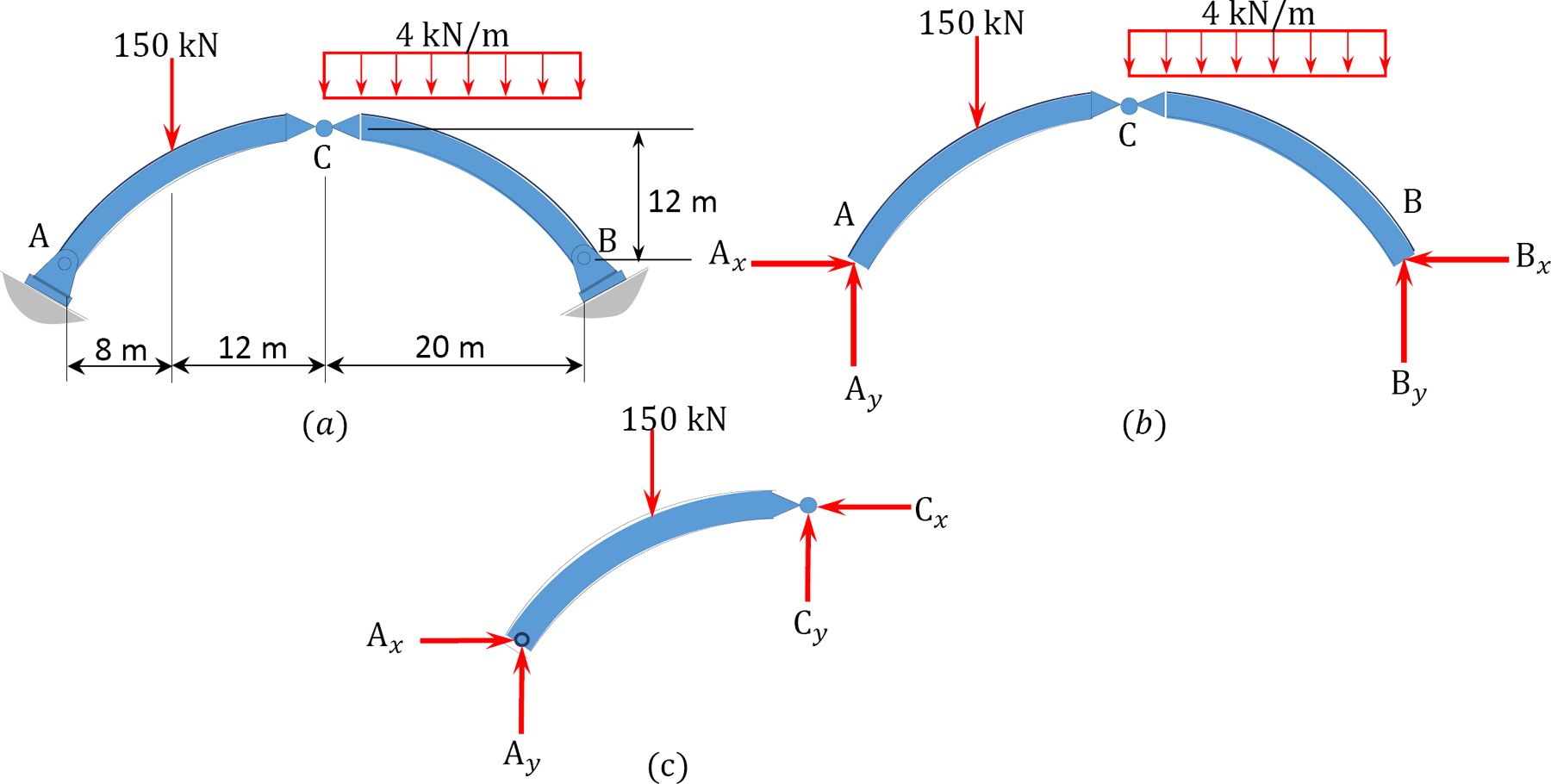
\(Fig. 6.4\). Parabolic arch.
Solution
Support reactions. The free-body diagram of the entire arch is shown in Figure 6.4b, while that of its segment \(AC\) is shown in Figure 6.4c. Applying the equations of static equilibrium to determine the arch’s support reactions suggests the following:
Entire arch.
\(\begin{array}{l}
+\curvearrowleft \sum M_{A}=0 \\
B_{y}(40)-150(8)-4(20)(30)=0 \\
B_{y}=90 \mathrm{kN} & B_{y}=90 \mathrm{kN} \uparrow \\
+\uparrow \sum F_{y}=0 \\
A_{y}+90-150-4(20)=0 \\
A_{y}=140 \mathrm{kN} & A_{y}=140 \mathrm{kN} \uparrow
\end{array}\)
Arch segment \(AC\).
\(\begin{array}{l}
+\curvearrowleft \sum M_{C}=0 \\
A_{x}(12)-140(20)+150(12)=0 \\
A_{x}=83.33 \mathrm{kN} & A_{x}=83.33 \mathrm{kN} \rightarrow
\end{array}\)
Entire arch again.
\(\begin{array}{l}
+\rightarrow \sum F_{x}=0 \\
83.33-B_{x}=0 \\
B_{x}=83.33 \mathrm{kN} & B_{x}=83.33 \mathrm{kN} \leftarrow
\end{array}\)
Normal thrust and radial shear. To determine the normal thrust and radial shear, find the angle between the horizontal and the arch just to the left of the \(150\mathrm{kN}\) load.
\(\begin{array}{l}
y=\frac{4 f x}{L^{2}}(L-x)=\frac{4 f}{L^{2}}\left(L x-x^{2}\right) \\
\tan \theta=y^{\prime}=\frac{4 f}{L^{2}}(L-2 x) \\
\quad=\frac{4(12)}{(40)^{2}}(40-2 \times 8)=0.72 \\
\quad=35.75^{\circ}
\end{array}\)
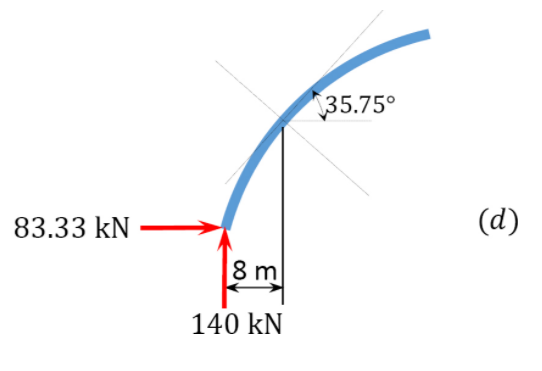
Normal thrust.
\(\begin{array}{rl}
N & =A_{y} \sin \left(35.75^{\circ}\right)+A_{x} \cos \left(35.75^{\circ}\right) \\
& =140 \sin \left(35.75^{\circ}\right)+83.33 \cos \left(35.75^{\circ}\right)=149.42 \mathrm{kN} & N=149.42 \mathrm{kN}
\end{array}\)
Radial shear.
\(\begin{array}{rl}
V= A_{y} \cos \left(35.75^{\circ}\right)+A_{x} \sin \left(35.75^{\circ}\right) \\
& =140 \cos \left(35.75^{\circ}\right)-83.33 \sin \left(35.75^{\circ}\right)=64.93 \mathrm{kN} & V=64.93 \mathrm{kN}
\end{array}\)
Example \(\PageIndex{3}\)
A parabolic arch is subjected to a uniformly distributed load of 600 lb/ft throughout its span, as shown in Figure 6.5a. Determine the support reactions and the bending moment at a section \(Q\) in the arch, which is at a distance of 18 ft from the left-hand support.
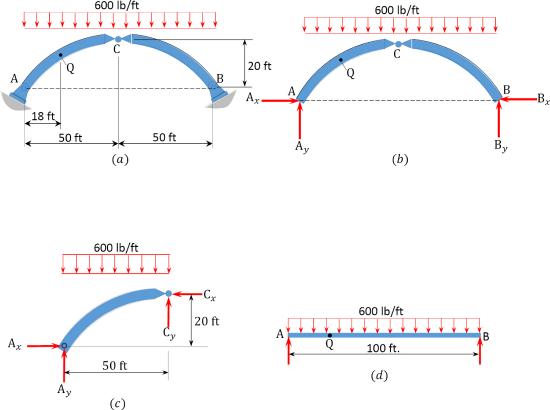
\(Fig. 6.5\). Parabolic arch.
Solution
Support reactions. The free-body diagram of the entire arch is shown in Figure 6.5b, while that of its segment \(AC\) is shown Figure 6.5c. Applying the equations of static equilibrium for the determination of the arch’s support reactions suggests the following:
Free-body diagram of entire arch. Due to symmetry in loading, the vertical reactions in both supports of the arch are the same. Therefore, \(A_{y}=B_{y}=\frac{w \mathrm{~L}}{2}=\frac{0.6(100)}{2}=30 \mathrm{kips}\)
The horizontal thrust at both supports of the arch are the same, and they can be computed by considering the free body diagram in Figure 6.5b. Taking the moment about point \(C\) of the free-body diagram suggests the following:
Free-body diagram of segment \(AC\). The horizontal thrust at both supports of the arch are the same, and they can be computed by considering the free body diagram in Figure 6.5c. Taking the moment about point \(C\) of the free-body diagram suggests the following:
\(\begin{array}{l}
+\cap \sum M_{C}=0 \\
A_{x}(20)-30(50)+0.6(50)(25)=0 \\
A_{x}=37.5 \text { kips } \quad A_{x}=37.5 \text { kips } \rightarrow
\end{array}\)
Free-body diagram of entire arch again.
\(\begin{array}{l}
+\uparrow \sum F_{x}=0 \\
37.5-B_{x}=0 \\
B_{x}=37.5 \text { kips } \quad B_{x}=37.5 \mathrm{kips} \leftarrow
\end{array}\)
Bending moment at point \(Q\): To find the bending moment at a point \(Q\), which is located 18 ft from support \(A\), first determine the ordinate of the arch at that point by using the equation of the ordinate of a parabola.
\(\begin{array}{l}
y=\frac{4 f x}{\mathrm{~L}^{2}}(L-x) \\
y_{x=18 \mathrm{ft}}=\frac{4(20)(18)}{(100)^{2}}(100-18)=11.81 \mathrm{ft}
\end{array}\)
The moment at \(Q\) can be determined as the summation of the moment of the forces on the left-hand portion of the point in the beam, as shown in Figure 6.5c, and the moment due to the horizontal thrust, \(A_{x}\). Thus, \(M_{Q}=A_{\gamma}(18)-0.6(18)(9)-A_{X}(11.81)\)
Example \(\PageIndex{4}\)
A parabolic arch is subjected to two concentrated loads, as shown in Figure 6.6a. Determine the support reactions and draw the bending moment diagram for the arch.
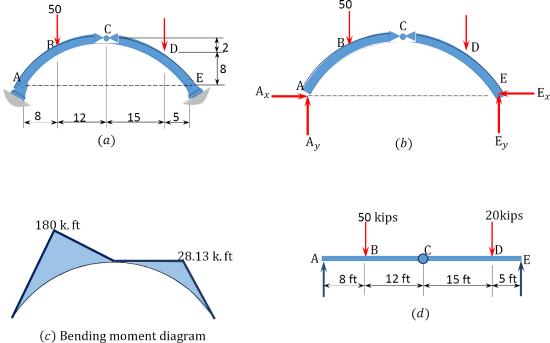
\(Fig. 6.6\). Parabolic arch.
Solution
Support reactions. The free-body diagram of the entire arch is shown in Figure 6.6b. Applying the equations of static equilibrium determines the components of the support reactions and suggests the following:
Entire arch.
\(\begin{array}{l}
+\curvearrowleft \sum M_{A}=0 \\
E_{y}(40)-50(8)-(20)(35)=0 \\
E_{y}=27.5 \text { kips } \quad \quad E_{y}=27.5 \mathrm{kip} \uparrow \\
+\uparrow \sum F_{y}=0 \\
A_{y}+27.5-50-20=0 \\
A_{y}=42.5 \mathrm{kips} \quad \quad A_{y}=42.5 \mathrm{kips} \uparrow
\end{array}\)
Arch segment \(EC\).
For the horizontal reactions, sum the moments about the hinge at \(C\).
\(\begin{array}{l}
+\curvearrowleft \sum M_{C}=0 \\
27.5(20)-E_{x}(10)-20(15)=0 \\
E_{x}=25 \text { kips } \quad E_{x}=25 \mathrm{kips} \leftarrow
\end{array}\)
Entire arch again.
\(\begin{array}{l}
+\uparrow \sum F_{x}=0 \\
-25+A_{x}=0 \\
A_{x}=25 \text { kips } \quad \quad A_{x}=25 \text { kips } \rightarrow
\end{array}\)
Bending moment at the locations of concentrated loads. To find the bending moments at sections of the arch subjected to concentrated loads, first determine the ordinates at these sections using the equation of the ordinate of a parabola, which is as follows:
\(y=\frac{4 f x}{L^{2}}(L-x)\)
\(y_{x=8 \mathrm{ft}}=\frac{4(10)(8)}{(40)^{2}}(40-8)=6.4 \mathrm{ft}\)
\(y_{x=5 \mathrm{ft}}=\frac{4(10)(5)}{(40)^{2}}(40-5)=4.375 \mathrm{ft}\)
When considering the beam in Figure 6.6d, the bending moments at \(B\) and \(D\) can be determined as follows:
\(\begin{array}{rlrl}
M_{B} & =A_{y}(8)-A_{x}(6.4) \\
& =42.5(8)-25(6.4)=180 \mathrm{k.ft} & M_{B}=180 \mathrm{k.ft}
\end{array}\)
\(\begin{aligned}
M_{D} &=E_{y}(5)-E_{x}(4.375) \\
&=27.5(5)-25(4.375)=28.13 \mathrm{k} . \mathrm{ft} \quad M_{D}=28.13 \mathrm{k} . \mathrm{ft}
\end{aligned}\)


